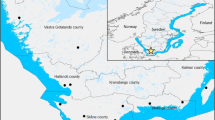Abstract
Xanthomonas translucens has been identified as the causal agent of pistachio dieback in Australia. Symptoms include decline, xylem staining, trunk and limb lesions, and excessive exudation of resin. Bacteria were previously isolated from stained wood in 2-year-old twigs but little was known about their presence in other parts of the tree. The pattern of staining and location of X. translucens were studied following felling and dissection of asymptomatic and diseased trees. Chestnut-coloured smears and specks occurred in the sapwood of diseased trees and were continuous from the trunk to 1–2-year-old twigs. X. translucens was isolated mainly from young sapwood (stained and unstained) of the main trunk, primary and younger branches and current season growth, less frequently from leaves and bunches, rarely from old, stained heartwood and not from roots and associated soil samples. Bacteria and pathogenic fungi were not found in the inner bark and cortex associated with lesions whereas the stained sapwood underlying the lesions yielded X. translucens. Scanning electron microscopy revealed bacteria in the main vessels of the xylem of stained tissue and tyloses in the proximity of colonised tissue. Information on the pattern of staining and location of the bacteria will facilitate pathogen detection, thereby improving the accuracy of disease diagnosis.
Similar content being viewed by others
References
Agrios G (2005) ‘Plant pathology.’ (Elsevier Academic Press: Sydney)
Du Plessis HJ (1990) Systemic invasion of plum seed and fruit by Xanthomonas campestris pv. pruni through stalks. Journal of Phytopathology 130, 37–45. doi: 10.1111/j.1439-0434.1990.tb01151.x
Edwards M, Taylor C (1998) Dieback and canker in Australian pistachios. Acta Horticulturae 470, 596–603.
Epstein L, Beede R, Kaur S, Ferguson L (2004) Rootstock effects on pistachio trees grown in Verticillium dahliae-infested soil. Phytopathology 94, 388–395. doi: 10.1094/PHYTO.2004.94.4.388
Facelli E, Taylor C, Scott E, Emmett R, Fegan M, Sedgley M (2002) First report of a bacterial disease of pistachios. Australasian Plant Pathology 31, 95–96. doi: 10.1071/AP01072
Facelli E, Taylor C, Scott E, Fegan M, Huys G, Emmett R, Noble D, Swings J, Sedgley M (2005) Identification of the causal agent of pistachio dieback in Australia. European Journal of Plant Pathology 112, 155–165. doi: 10.1007/s10658-005-3120-9
John S, Scott E, Wicks T, Hunt J (2004) Interactions between Eutypa lata and Trichoderma harzianum. Phytopathologia Mediterranea 43, 95–104.
Maggs DH (1982) ‘An introduction to pistachio growing in Australia.’ (Commonwealth Scientific and Industrial Research Organisation: Adelaide)
Marefat A, Ophel-Keller K, Scott E, Sedgley M (2006a) The use of ARMS PCR in detection and identification of xanthomonads associated with pistachio dieback in Australia. European Journal of Plant Pathology 116, 57–68. doi: 10.1007/s10658-006-9038-z
Marefat A, Scott ES, Ophel-Keller K, Sedgley M (2006b) Genetic, phenotypic and pathogenic diversity among xanthomonads isolated from pistachio (Pistacia vera) in Australia. Plant Pathology 55, 639–649. doi: 10.1111/j.1365-3059.2006.01437.x
Miles WG, Daines RH, Rue JW (1977) Presymptomatic egress of Xanthomonas pruni from infected peach leaves. Phytopathology 67, 895–897. doi: 10.1094/Phyto-67-895
Moffett M, Croft B (1983) Xanthomonas. In ‘Plant bacterial diseases. A diagnostic guide’. (Eds P Fahy, G Persley) pp. 189–228. (Academic Press: Sydney)
Robinson B (1997) Pistachios. In ‘The new rural industries. A handbook for farmers and investors’. (Ed. K Hyde) pp. 436–443. (Rural Industries Research and Development Corporation: Canberra)
Rosengarten F (2004) ‘The book of edible nuts.’ (Dover Publications: New York)
Rudolph K (1993) Infection of the plant by Xanthomonas. In “Xanthomonas’. (Eds JG Swings, EL Civerolo) pp. 193–264. (Chapman & Hall: London)
Schaad NW, Wilson EE (1970) Pathological anatomy of the bacterial phloem canker disease of Juglans regia. Canadian Journal of Botany 48, 1055–1060. doi: 10.1139/b70-152
Sedgley M, Scott E, Facelli E, Emmett R, Taylor C (2004) ‘Pistachio canker epidemiology.’ (Horticulture Australia Ltd: Sydney)
Siegel S (1956) ‘Nonparametric statistics for the behavioral sciences.’ (McGraw-Hill: London)
Stevenson JF, Matthews MA, Greve LC, Labavitch JM, Rost TL (2004) Grapevine susceptibility to Pierce’s disease II: Progression of anatomical symptoms. American Journal of Enology and Viticulture 55, 238–245.
Suhayda CG, Goodman RN (1981) Early proliferation and migration and subsequent xylem occlusion by Erwinia amylovora and the fate of its extracellular polysaccharide in apple shoots. Phytopathology 71, 697–707. doi: 10.1094/Phyto-71-697
Swings JG, Civerolo EL (1993) “Xanthomonas.’ (Chapman& Hall: London)
Taylor C, Edwards M (2000) ‘Managing canker and dieback in pistachios.’ (Department of Natural Resources and Environment, Agriculture Victoria: Mildura)
Teviotdale BL, Michailides TJ, Pscheidt JW (2002) ‘Compendium of nut crop diseases in temperate zones.’ (APS Press: St Paul, MN)
Author information
Authors and Affiliations
Corresponding author
Rights and permissions
About this article
Cite this article
Facelli, E., Taylor, C., Williams, N.M. et al. Location of Xanthomonas translucens in pistachio trees. Australasian Plant Pathology 38, 584–593 (2009). https://doi.org/10.1071/AP09044
Received:
Accepted:
Issue Date:
DOI: https://doi.org/10.1071/AP09044



